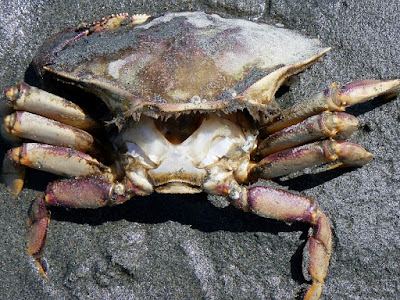And I just happened to be looking his way when he started to struggle wildly, and fell out of the mussel onto the sandy bottom. There, out in the open, he squirmed and twisted, and slid out of the back of his shell; he was molting!
In the weeks before this, he had been partially dissolving his shell, using the calcium carbonate to build himself a new shell inside it. When it was ready, he started taking in extra water, swelling himself up enough to crack open the old shell at the back, where the top shell joins the belly plate. Then he pushed his way backwards out of the old shell, pulling each leg and pincer, the head and all its appendages out in their new skin.* This is possible because the new shell is as soft as wet paper.
This final stage of the molt can take 15 minutes, according to Alaska Fisheries Science Center. My little shore crab managed it in about 5.
Except that there was a problem; he didn't detach himself completely, and the old shell stayed stuck to his rear end.
I don't know how he managed this, after backing out, and he moved too fast to see what happened.
When a crab molts, he leaves behind the ends of his digestive system: his esophagus, his stomach lining, and the last bit of his intestine. He takes his gills, but leaves a mold ("ghost gills") behind. Somewhere, some part of this old equipment didn't separate cleanly, and it left him with his rear end trapped.
 |
| Struggling crab. I don't know if the triangular abdominal plate belongs to the new shell or the old one. The new pincers are noticeably larger than the old ones. |
If a newly-molted crab is vulnerable, this little guy was doubly so. His legs were still soft at first, and he pushed feebly against the old shell with them, to no effect. He found it difficult to walk; the empty shell swayed in the current, and sometimes flipped him over on his back.
Eventually, he stiffened up a bit; his pincers seemed to grow, and he used those to push at the shell. Then he clambered over things, jamming the old shell into cracks and pulling. No luck. One of the other crabs, much bigger than he, came over and picked at him, but without hurting him. This went on for two hours. I felt so much like reaching in and "helping", but I knew I would probably damage him, so all I could do was cheer him on from the sidelines.
I replaced the shells and seaweed in the tank while I waited, and the crab scooted under a clam shell to work in privacy, so I turned out the light and left him to it.
In the morning, I looked for him; he was mostly hidden under a rock, but his molted shell was left under the clam. Good! He will have to hide for a couple of days, until his shell finishes hardening up, and the ends of his intestines rebuild themselves. I think he'll be ok.
*Laurie said that this is like a woman giving birth. That's exactly the way it felt, watching.
Update, July 13: The crab was out for supper tonight, so he's made it ok.




wow. would he have survived this, if your tank had had all of its usual occupants?
ReplyDeleteThis was a great saga! A little bit of an edge-of-your-seat thriller - I'm glad he managed to separate himself at the end. :)
ReplyDelete(ps I found your blog through Rock Paper Lizard - I'm glad I wandered over!)
Another interesting post. Glad all was well that ended well ... that ends dropped off etc.
ReplyDeleteSarah, I don't know. The worst predators on crabs would be the other crabs, birds, and fish. And there are no birds and fish in my tank. :) Just the crabs, and they're still there.
ReplyDeleteBy the way, last night the tiny crab was out and about, so he made it. (I'll update the post.)